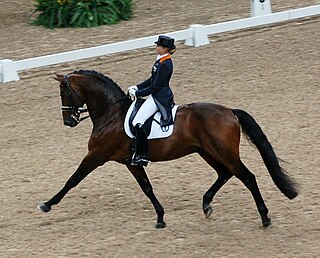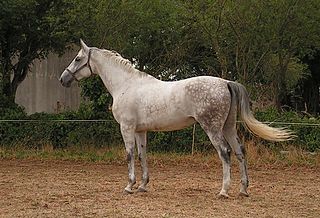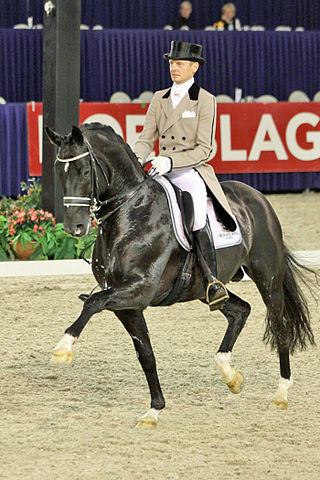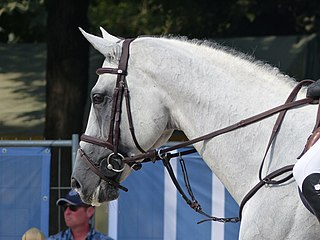Related Research Articles

Warmbloods are a group of middle-weight horse types and breeds primarily originating in Europe and registered with organizations that are characterized by open studbook policy, studbook selection, and the aim of breeding for equestrian sport. The term distinguishes these horses from both heavy draft horses and refined light saddle horses such as the Thoroughbred, Arabian, and Akhal-Teke. Although modern warmbloods are descended from heavier agricultural types systematically upgraded by hotblood influence, the term does not imply that warmbloods are direct crosses of "cold" and "hot".

A Hanoverian is a Warmblood horse breed originating in Germany, which is often seen in the Olympic Games and other competitive English riding styles, and has won gold medals in all three equestrian Olympic competitions. It is one of the oldest, most numerous, and most successful of the Warmblood breeds. Originally a cavalry horse, infusions of more Thoroughbred blood lightened it to make it more agile and useful for competition. The Hanoverian is known for a good temperament, athleticism, beauty, and grace.

A horse show is a judged exhibition of horses and ponies. Many different horse breeds and equestrian disciplines hold competitions worldwide, from local to the international levels. Most horse shows run from one to three days, sometimes longer for major, all-breed events or national and international championships in a given discipline or breed. Most shows consist of a series of different performances, called classes, wherein a group of horses with similar training or characteristics compete against one another for awards and, often, prize money.

The Oldenburg or Oldenburger is a warmblood horse from the north-western corner of Lower Saxony, what was formerly the Grand Duchy of Oldenburg. The breed was built on a mare base of all-purpose farm and carriage horses, today called the Alt-Oldenburger. The modern Oldenburg is managed by the Association of Breeders of the Oldenburger Horse, which enacts strict selection of breeding stock to ensure that each generation is better than the last. Oldenburgers are tall sport horses with excellent gaits and jumping ability. The breeding of Oldenburg horses is characterized by very liberal pedigree requirements and the exclusive use of privately owned stallions rather than restriction to a state-owned stud farm.

The Selle Français (SF) is a breed of sport horse from France. It is renowned primarily for its success in show jumping, but many have also been successful in dressage and eventing. An athletic horse with good gaits, it is usually bay or chestnut in color. The Selle Français was created in 1958 when several French riding horse breeds were merged into one stud book. The new breed was meant to serve as a unified sport horse during a period when horses were being replaced by mechanization and were transforming into an animal used mainly for sport and leisure.
The International Federation for Equestrian Sports is the international governing body of equestrian sports.

The Irish Sport Horse, or Irish Hunter, is an Irish breed of warmblood sporting horse, used mostly for dressage, eventing and show-jumping. It was bred from 1923 by cross-breeding of Irish Draught and Thoroughbred stock. There was some limited intromission of Hanoverian, Selle Français and Trakehner blood in the 1990s. It is a recognised true breed – foals may only be registered in the main section of the stud-book if both parents are registered in that section.

A Dutch Warmblood is a warmblood type of horse registered with the Koninklijk Warmbloed Paardenstamboek Nederland (Royal Warmblood Studbook of the Netherlands, which governs the breeding of competitive dressage and show jumping horses, as well as the show harness horse and Gelderlander, and a hunter studbook in North America. Developed through a breeding program that began in the 1960s, the Dutch are some of the most successful competition horses developed in postwar Europe.

A sport horse or sporthorse is a type of horse, rather than any particular breed. The term is usually applied to horses bred for the traditional Olympic equestrian sporting events of dressage, eventing, show jumping, and combined driving, but the precise definition varies. In the United States, horses used in hunt seat and show hunter competition are often classed as sport horses, whereas the British show hunter is classified as a "show horse."

The Belgian Warmblood or Belgisch Warmbloedpaard is a Belgian breed of warmblood sport horse. It is bred for dressage, for show-jumping and for three-day eventing. It is one of three Belgian warmblood breeds or stud-books, the others being the Zangersheide and the Belgian Sport Horse – to which it is quite similar.

The Westphalian or Westfalen is a warmblood horse bred in the Westphalia region of western Germany. The Westphalian is closely affiliated with the state-owned stud farm of Warendorf, which it shares with the Rhinelander. Since World War II, the Westphalian horse has been bred to the same standard as the other German warmbloods, and they are particularly famous as Olympic-level show jumpers and dressage horses. Next to the Hanoverian, the Westphalian studbook has the largest breeding population of any warmblood in Germany.
Equestrian Canada, formerly known as Equine Canada and commonly known by its acronym, EC, is Canada’s comprehensive national governing body for equestrian sport. It is the executive branch of Canada's Olympic and Paralympic equestrian teams; the national association and registry of Canadian equestrian athletes; the national regulatory body for equestrian coaches, competition organizers, and judges; and the national federation of Canadian horse breeders and Canadian breed registries.

Totilas, also known from 2006 to 2011 as Moorlands Totilas, and nicknamed "Toto", was a Dutch Warmblood stallion standing 17.1 hands high who was considered to be one of the most outstanding competitive dressage horses in the world, the first horse to score above 90 in dressage competition, and the former holder of the world record for the highest dressage score in Grand Prix Freestyle Dressage.
Para-equestrian is an equestrian sport governed by the International Federation for Equestrian Sports (FEI), and includes two competitive events: One is para-equestrian dressage, which is conducted under the same basic rules as conventional dressage, but with riders divided into different competition grades based on their functional abilities. The other is para-equestrian driving, which operates under the same basic rules as combined driving but places competitors in various grades based on their functional abilities.

Big Star is a Dutch Warmblood stallion who competes in show jumping with the British rider Nick Skelton. Part of the gold medal team at the London Olympics, Big Star was elected the KWPN horse of the year and formed a partnership with Skelton in 2012. After good performances in the following year, he was temporarily taken out of competition because of a leg injury. Skelton has described the bay stallion, son of Quick Star and grandson of Nimmerdor as "the best horse he has ever ridden". Apart from his show-jumping, Big Star is a successful breeding stallion, licensed in 21 studbooks for sport horses. Some of his foals have won notable victories.
The German Equestrian Federation(Deutsche Reiterliche Vereinigung) is an umbrella organization in Germany for equestrian sports and breeding. It is the governing body for the majority of equestrian sports and their organization in Germany, including FEI-recognized disciplines of dressage, eventing, show jumping, vaulting, endurance, reining, para-equestrian, and driving. It also develops and enforces the rules for other events at horse shows. It is colloquially known as FN, short for the international term Fédération Équestre Nationale. The organisation runs the FNverlag, a publishing house for related books and other media

The Zangersheide is a Belgian breed or stud-book of warmblood sport horses. It is one of three Belgian warmblood breeds or stud-books, the others being the Belgian Sport Horse and the Belgian Warmblood.

Hello Sanctos is a bay gelding. He is listed in stud-book sBs and ridden in show jumping. From 2014 to 2015, he was the best show jumping horse in the world. His rider was Scott Brash. He is the only horse in the world to complete a Grand Slam of Show Jumping. He stopped due to an injury in December 2015. The horse returned in February 2017.

The Polish sport horse is a studbook of sport horses, from Poland. This recent studbook, which does not constitute a breed, comes from selective breeding for equestrian sports. It is selected from Malopolski and Wielkopolski, both of which perform poorly on the international sporting scene, and from crosses with various sport horses. The animals are large, with muscular rumps and strong legs.

The British Warmblood is a breed registry of sport horses created in the UK in 1977 by the British Warmblood Society, with open registration. It comprises a base of European sport horses including Hanoverians, Dutch Warmbloods and Danish Warmbloods. The studbook was officially recognized in 1994, and became widely adopted by British breeders in the 2000s.